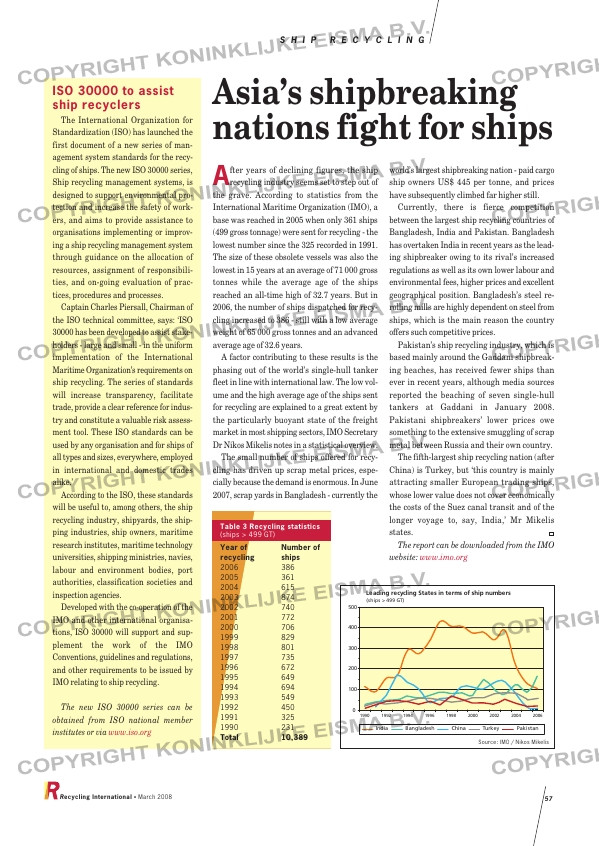Page 57 from: March 2008

Asia’s shipbreaking
nations fight for ships
ISO 30000 to assist
ship recyclers
The International Organization for
Standardization (ISO) has launched the
first document of a new series of man-
agement system standards for the recy-
cling of ships. The new ISO 30000 series,
Ship recycling management systems, is
designed to support environmental pro-
tection and increase the safety of work-
ers, and aims to provide assistance to
organisations implementing or improv-
ing a ship recycling management system
through guidance on the allocation of
resources, assignment of responsibili-
ties, and on-going evaluation of prac-
tices, procedures and processes.
Captain Charles Piersall, Chairman of
the ISO technical committee, says: ‘ISO
30000 has been developed to assist stake-
holders – large and small – in the uniform
implementation of the International
Maritime Organization’s requirements on
ship recycling. The series of standards
will increase transparency, facilitate
trade, provide a clear reference for indus-
try and constitute a valuable risk assess-
ment tool. These ISO standards can be
used by any organisation and for ships of
all types and sizes, everywhere, employed
in international and domestic trades
alike.’
According to the ISO, these standards
will be useful to, among others, the ship
recycling industry, shipyards, the ship-
ping industries, ship owners, maritime
research institutes, maritime technology
universities, shipping ministries, navies,
labour and environment bodies, port
authorities, classification societies and
inspection agencies.
Developed with the co-operation of the
IMO and other international organisa-
tions, ISO 30000 will support and sup-
plement the work of the IMO
Conventions, guidelines and regulations,
and other requirements to be issued by
IMO relating to ship recycling.
The new ISO 30000 series can be
obtained from ISO national member
institutes or via www.iso.org
S H I P R E C Y C L I N G
Recycling International • March 2008 57
Leading recycling States in terms of ship numbers
(ships > 499 GT)
0
100
200
300
400
500
India Bangladesh China Turkey Pakistan
1990 1992 1994 1996 1998 2000 2002 2004 2006
Source: IMO / Nikos Mikelis
After years of declining figures, the shiprecycling industry seems set to step out of
the grave. According to statistics from the
International Maritime Organization (IMO), a
base was reached in 2005 when only 361 ships
(499 gross tonnage) were sent for recycling – the
lowest number since the 325 recorded in 1991.
The size of these obsolete vessels was also the
lowest in 15 years at an average of 71 000 gross
tonnes while the average age of the ships
reached an all-time high of 32.7 years. But in
2006, the number of ships dispatched for recy-
cling increased to 386 – still with a low average
weight of 65 000 gross tonnes and an advanced
average age of 32.6 years.
A factor contributing to these results is the
phasing out of the world’s single-hull tanker
fleet in line with international law. The low vol-
ume and the high average age of the ships sent
for recycling are explained to a great extent by
the particularly buoyant state of the freight
market in most shipping sectors, IMO Secretary
Dr Nikos Mikelis notes in a statistical overview.
The small number of ships offered for recy-
cling has driven up scrap metal prices, espe-
cially because the demand is enormous. In June
2007, scrap yards in Bangladesh – currently the
world’s largest shipbreaking nation – paid cargo
ship owners US$ 445 per tonne, and prices
have subsequently climbed far higher still.
Currently, there is fierce competition
between the largest ship recycling countries of
Bangladesh, India and Pakistan. Bangladesh
has overtaken India in recent years as the lead-
ing shipbreaker owing to its rival’s increased
regulations as well as its own lower labour and
environmental fees, higher prices and excellent
geographical position. Bangladesh’s steel re-
rolling mills are highly dependent on steel from
ships, which is the main reason the country
offers such competitive prices.
Pakistan’s ship recycling industry, which is
based mainly around the Gaddani shipbreak-
ing beaches, has received fewer ships than
ever in recent years, although media sources
reported the beaching of seven single-hull
tankers at Gaddani in January 2008.
Pakistani shipbreakers’ lower prices owe
something to the extensive smuggling of scrap
metal between Russia and their own country.
The fifth-largest ship recycling nation (after
China) is Turkey, but ‘this country is mainly
attracting smaller European trading ships,
whose lower value does not cover economically
the costs of the Suez canal transit and of the
longer voyage to, say, India,’ Mr Mikelis
states.
The report can be downloaded from the IMO
website: www.imo.org
Table 3 Recycling statistics
(ships > 499 GT)
Year of Number of
recycling ships
2006 386
2005 361
2004 615
2003 874
2002 740
2001 772
2000 706
1999 829
1998 801
1997 735
1996 672
1995 649
1994 694
1993 549
1992 450
1991 325
1990 231
Total 10,389
RI_053 Shipbreaking:Opmaak 1 28-02-2008 14:00 Pagina 57



